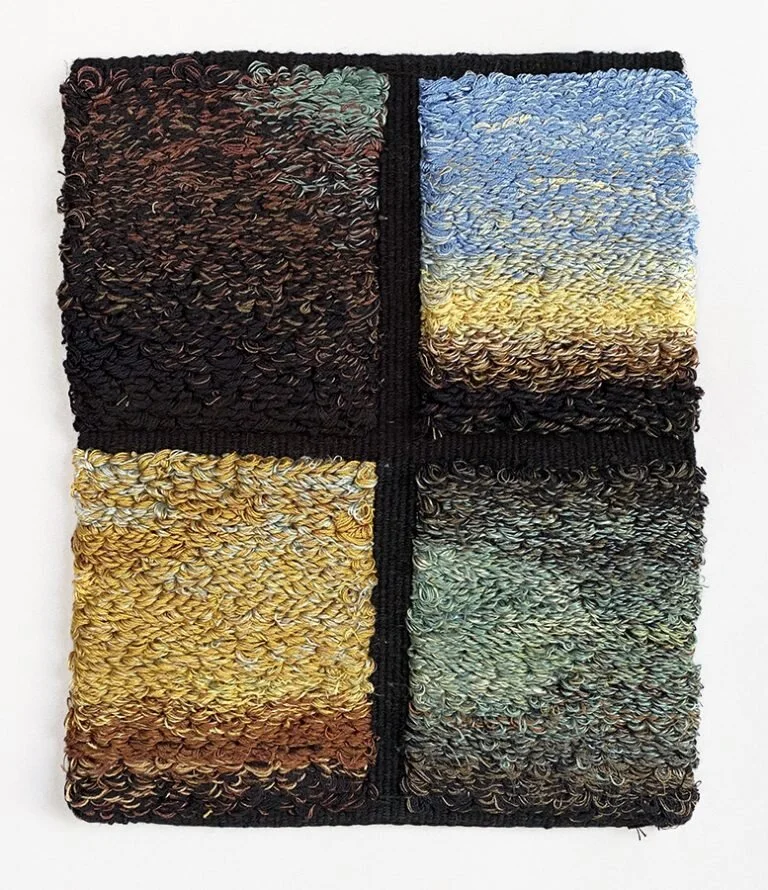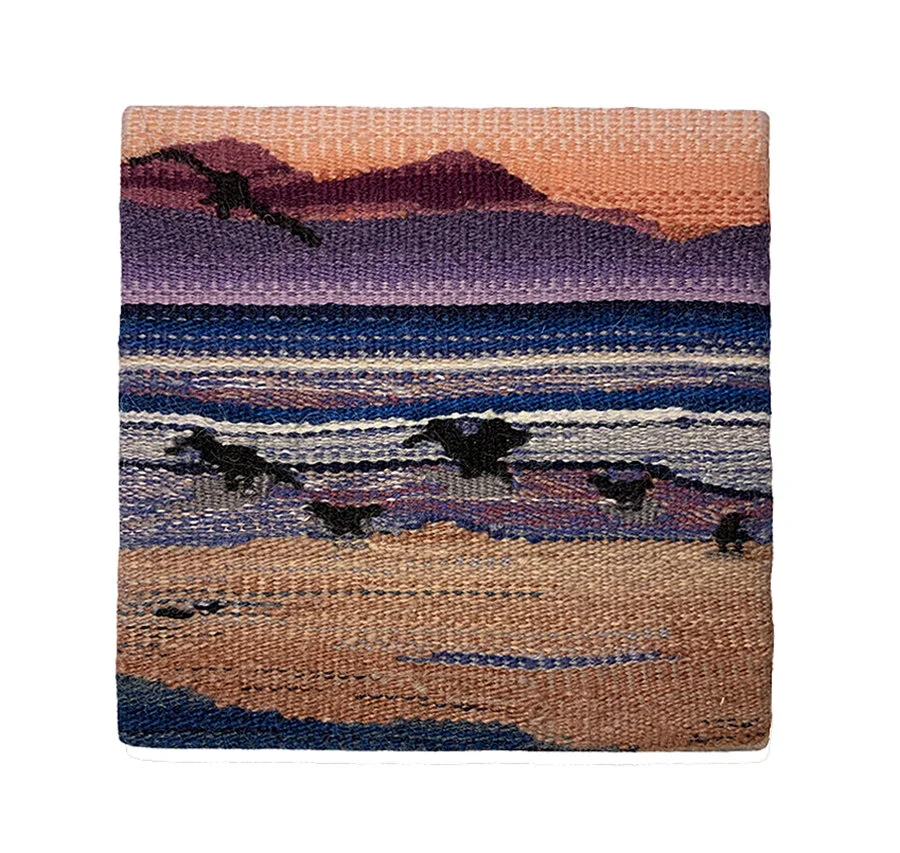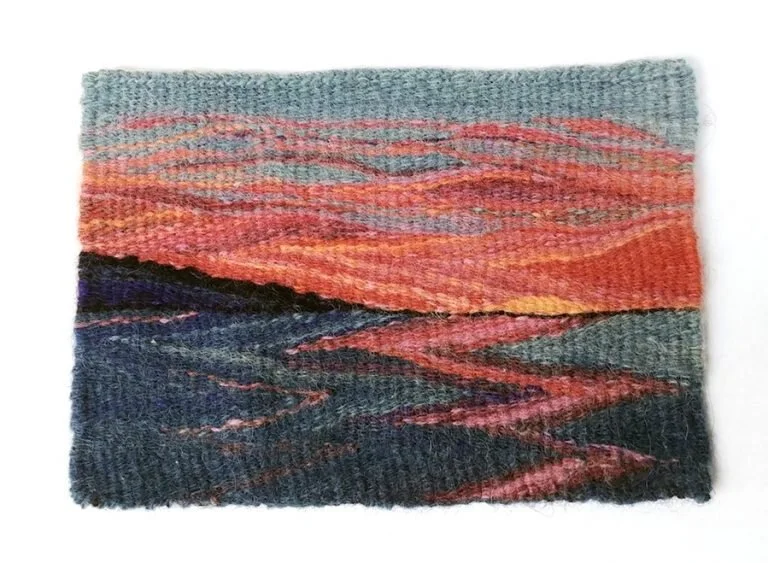Renditions 2020: Texture and Movement
This is the second post in a series on Renditions 2020, the Unjuried Small Format Exhibition put together by the American Tapestry Alliance. The first post was It’s in the Details in case you missed it.
The show was originally scheduled to be at the HGA conference, Convergence, but as a result of Covid-19 restrictions, it is now being shown online. Lucky you! You can view all of the entries here.
For this post, I’m focusing on Texture and Movement, probably my personal favorite element and principle in art. Below are photos of the pieces, followed by quotes from the artists.
In my early years of weaving I wove a lot of tapestries in the Rya technique. So, not surprisingly, I was drawn to this piece by Nicki Bair. Nicki’s piece is part of the exhibit by the Seaside Weavers group. She told me that this year the group challenge was to honor Jean Christoph Norman with a rendering of woven panels in homage to "Biographies," his tile piece hanging at the Picasso museum in Paris. They were given specific guidelines to follow and all are 8 inches by 10 inches; take a look at the other entries here.
Nicki Bair, “Biographies 1”
Seaside Weavers in Los Angeles has had a tapestry group for several decades, continuing today with an active and eclectic group of tapestry weavers. This is the ninth time we have submitted a group entry to ATA's unjuried exhibit. Our group challenge was to create four woven tiles which would fit right in with the tiles that Norman created in paint.
I had the pleasure of installing ATA's unjuried show in Reno a couple of years ao and saw many tapestry weavers adding texture to their tapestries with loops. Renditions was the perfect exhibit for me to experiment with adding texture to my piece. I used a rya technique for my four tiles. The yarns used were 20/2 cottons and a variety of silks of a similar or smaller nature from my stash. I do not remember the sett but it was probably 12 epi. I do remember I used 6-8 strands in each warp bundle in order to get the shading just right. To keep the rya loops the same height I wrapped the warp around a knitting needle. This blending technique was time consuming but not that much more than using multiple dots of yearn color to achieve the same result. The textural effect is wonderful and I hope to use it again sometime in the future.
You can see more of Nicki’s work on her website.
Joan Montalban, “Beach Birds at Sunset”
Part of the Central Coast Weavers group, Joan’s piece is also loaded with texture; this time through her choice of yarns.
My entry for the Renditions exhibit was based on a photo I took one evening at Pismo Beach. I loved the colors of that sky, how it was reflected in the sand and the black silhouettes of the birds. It seemed like the perfect subject for our Central Coast Tapestry weavers and our theme, the Central Coast of California. I had a hemp warp of 8 epi and I worked on a 4 harness floor loom, which I sometimes use for tapestry mostly for control of the selvages and ease of changing sheds. For the weft, I chose wools from my stash in colors in keeping with those in the photo, most which were hand spun and/or dyed, and primarily worsted weight. My challenge was to try to recreate the textures of the wet sand, foaming surf, placid sky and grace of the birds as they were taking off and landing. I used the different yarns, from coarse to smooth, to try to create these distinctions in my piece. I felt time constraints to meet the submission deadline, and there are several details, mainly in the contrast and form of the birds I would have liked more time to enhance. I feel the piece would have worked better with a closer sett to allow more detail. The finished size of Beach Birds at Sunset is 10” x 10”.
Bonnie Britton, “Bay Fog Sanctuary”
Bonnie Britton’s piece is exhibited as part of The Eccentrics of the Santa Cruz Textile Arts Guild. Her piece is 7” x 7” and woven at 6 epi with a linen warp. The weft is cotton and linen of various sizes, and little strips of Shibori Indigo cotton fabric.
I travel from the Monterey Bay to the Sonoran Desert a few times each year. The contrasting beauty of these two places is mesmerizing. In Santa Cruz, I awake under the marine layer most mornings, sometimes lasting until two in the afternoon. Gradually the mysterious fog recedes and exposes the brightness of day, the subtle changes of light, and the activity of the ocean. The Monterey Bay is an ocean Sanctuary, Santa Cruz is a Sanctuary city, and my Sanctuary. The design is a rendition of my large handmade paper piece.
Carol Ward, “Psalm 121”
Carol’s piece is loaded with both texture and movement. She has an even different approach to achieve this effect.
Psalm 121, like most of my work, was created as a prayer over my children and grandchildren with messages I want to give them intended to bring truth, love and light into the sometimes dark world. I began this piece in February 2020, just before the world turned upside down with the pandemic so the message now feels even more relevant. "...the LORD himself watches over you!". My work essentially is my prayers made visual. I think my process is a lot like a painter. I'm interested in creating painterly like movement and rhythms in my images with fiber and have a free form approach to weaving. I love the process of weaving a simple piece of cloth with linen, the methodical, rhythmic slow process gives me time to pray and think through the piece forming in my mind. I begin with a "blank canvas" piece I weave with raw linen, paint a kind of sketch of shapes and lines directly on the woven linen and then begin to weave back into it, led by my prayers and watercolor sketches inspiring the piece.
Maria Robinson, “The Ebb Tide”
Maria Robinson’s piece also evokes a feeling of movement and texture. She exhibited with the group Tapestry Weavers in New England. Her piece is 8” by 10”.
The creation of this tapestry started with a photograph taken during my walk at the boardwalk between Long Island Sound and the marshes. My favorite part of boardwalk is a spot at the bridge crossing the tributary.
I had taken so many photos of that spot with the views not looking toward the ocean but toward the marshes. As the tide moved from the marsh out to the sea, the sea became a kinetic art scene. The level of energy, color depending on the tide, weather and season always surprised me with its beauty or subtle changes or gorgeous views.
Photographing those moments became my obsession. Most of my tapestries are woven using a color blending technique. This tapestry was woven with spontaneity from the bottom to top on an old painting frame with set of 8 epi with a combination of wool and commercial yarns using single or double strand technique.
Rebecca Powell, “Grasses Rendered”
The dancing grasses in Rebecca Powell’s weaving is an elegant display of movement. It is 9.5” x 9.5” at 8 epi. The warp is cotton seine twine and the weft is both commercial and hand dyed wool.
I prefer to weave either natural or abstract images. I love the movement and layering of grass, and have often photographed it. In designing this tapestry I think I unconsciously had Albrecht Durer’s “The Great Piece of Turf” in mind, with its focus on a minute, often overlooked aspect of nature. While having fun weaving the many kinds of green, I wanted to dramatize the image with shadows of blue and purple, and a red frame to contrast the greens.
Peg McCollough, “Currently Playing in My Neighborhood”
Peg is also a part of the Santa Cruz group and the Monterey Bay theme. Her piece is woven at 8 epi and measures 6.5 inches by 5 inches.
I am a natural dyer and "forager" ( as well as a dabbler in many other things) and so for the yarn I went to my assortment of natural dyed yarns that might be appropriate for tapestry. They were all "rescued", mostly wool. I bundled them, mostly groups of threes and many of the dyes are mushroom dyes (back to the forager part of me). I started without much of a plan except that I started by trying a few of the yarns to see if they would work out bundled and how they behaved. ( you can see those picks at the bottom of the photo and later took them out). Then I just dived in. I did want to get the idea of the water and the light on the water with the wedge weave and the way the more patterned wedge weave water gave way to the more disorganized swirl in the sky. I didn't use a cartoon as I was sort of intimidated by that and I just sort of started weaving with intent to start the "real" piece later.
Jean Clark, “Campfire”
Another wedge weave design, Jean used raffia, bast fibers, and metallics to create this tapestry absolutely writhing with movement. It is 7 3/4" x 5 3/4” x 3/4”. The warp is cotton seine twine at 6 epi.
In my younger days (1970’s) free weaving and tapestry were all the rage. Then, as now, I liked the spontaneity of weaving with yarn meandering through the warps. Completely enamored with Silvia Heyden’s work (The Making of Modern Tapestry) and exhibitions of her work, I started to try to find my voice in tapestry. I had been at the floor loom for so long, it was hard to not weave straight across at first. With support from a bimonthly tapestry study group (Chattahoochee Handweavers Guild), we pushed ourselves to move forward. Everyone in the group was different, I was the rebel, unwilling or unable to do cartoon tapestry after the confines of traditional handweaving.
I also used unconventional materials in a random wedge weave way, and liked to mount my small pieces in a off-the-shelf picture frame. A somewhat lonely tapestry weaving existence, but the process was new and exciting to me, and my friends did not try to change me! I stayed away from the Web while I was in this exploration process. Seeing how/what other tapestry artists were doing distracted from what I was supposed to discover as my own.
Sharon Crary, “Three Tulips”
And one last example of movement with wedge weave from Sharon Crary. It is 8 inches by 10 inches in size.
My sett is 9 with a seine twine cotton warp, probably 12/6.
The red, greens and yellow are primarily Bernat crewel wool that came from a weaver who lived to be 100. I use 3 strands at once to facilitate the color blending. The black is some fuzzy skinny wool I had in my stash. I wanted the black areas to visually “sink” and be texturally different from the smoother flowers.
I use a modified wedge weave in the leaves to contrast linearly with the regular horizontal weaving in the flowers. Sumac outlines some of the edges of the petals. When I weave the eccentric areas I want the curving lines to follow the deliberately created ripples and dimension in the tapestry.
That wraps up part 2 of Renditions 2020: Texture and Movement. So fun to hear the artists talk about their inspiration and techniques. Join me next week for the 3rd installment. And if you need a reminder, you can sign up for my newsletter here.








